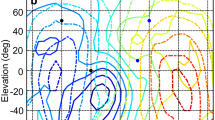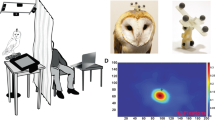Summary
The modulatory influence of a synchronously moving visual noise background on responsiveness to an optimally-oriented moving bar stimulus was investigated in visual cortical area 18 of the lightly-anaesthetized cat. The bar and noise background were swept along the axis orthogonal to bar orientation, with the same phase, velocity and amplitude of motion. Cells which were insensitive to motion of visual noise per se or weakly responsive to individual ‘grains’ in the noise sample showed suppression of bar-evoked responses by simultaneous motion of the noise background. Percent suppression declined with increase in bar length, over a range which could exceed the maximum estimate of receptive field length. The decline in percent suppression was non-linear, becoming progressively flatter in slope as bar length was increased until an asymptotic value was reached; observations on end-stopped cells and on end-free cells with restricted length summation verified that percent suppression was related specifically to the length of the comparison bar and not to the strength of response it evoked. Percent suppression and the extent over which it declined with increase in bar length were comparable for preferred and opposite directions of bar motion even in cells with radically different length-response functions in the two directions, including end-stopped cells with direction-selective end-zones. In contrast to end-inhibition, which was maximal at or near the preferred velocity for a bar of optimal length, percent suppression by motion of the noise background was essentially velocity-invariant; in velocity tuned and velocity high-pass cells, background motion reduced the slope(s) of the velocity-response function, implying that the suppressive action of moving noise backgrounds is divisive rather than subtractive. It is argued that the suppression derives predominantly from an axo-somatic noise-sensitive inhibitory input from superficial- and deep-layer, large basket cells in orientation ‘columns’ at some distance from those of their target cells.
Similar content being viewed by others
References
Ahmed B, Hammond P (1983) Response of cat retinal ganglion cells to motion of visual texture. Exp Brain Res 53: 444–450
Bishop PO, Kato H, Orban GA (1980) Direction-selective cells in complex family in cat striate cortex. J Neurophysiol 43: 1266–1283
Blomfield S (1974) Arithmetical operations performed by nerve cells. Brain Res 69: 115–124
Boyapati J, Henry GH (1987) The duplex character of the corticofugal pathway from the striate cortex to the lateral geniculate complex of the cat. Vision Res 27: 723–726
Bullier J, Kennedy H, Salinger W (1984) Branching and laminar origin of projections between visual cortical areas in the cat. J Comp Neurol 228: 329–341
Creutzfeldt OD, Ito M (1968) Functional synaptic organization of primary visual cortex neurones in the cat. Exp Brain Res 6: 324–352
Crook JM (1987) A neurophysiological investigation of the feline extrastriate visual cortex (area 18) using oriented and textured stimuli: a comparison with area 17. PhD thesis. University of Keele, UK
Crook JM (1990) Directional tuning of cells in area 18 of the feline visual cortex for visual noise, bar and spot stimuli: a comparison with area 17. Exp Brain Res 80: 545–561
Dean AF, Hess RF, Tolhurst DJ (1980) Divisive inhibition involved in direction selectivity. J Physiol 308: 84–85P
Dinse HRO, von Seelen W (1981) On the function of cell systems in area 18, Part II. Biol Cybern 41: 59–69
Dreher B, Cottee LJ (1975) Visual receptive-field properties of cells in area 18 of cat's cerebral cortex before and after acute lesions in area 17. J Neurophysiol 38: 735–750
Dubin MW, Cleland BG (1977) Organization of visual inputs to interneurons of lateral geniculate nucleus of the cat. J Neurophysiol 40: 410–427
Ferster D, Lindström S (1983) An intracellular analysis of geniculocortical connectivity in area 17 of the cat. J Physiol 342: 181–215
Fischer B, Krüger J (1974) The shift-effect in the cat's lateral geniculate nucleus. Exp Brain Res 21: 225–227
Freund TF, Martin KAC, Whitteridge D (1985) Innervation of cat visual areas 17 and 18 by physiologically identified X- and Y-type thalamic afferents. I. Arborization patterns and quantitative distribution of postsynaptic elements. J Comp Neurol 242: 263–274
Frömel G (1980a) Extraction of objects from structured backgrounds in the cat superior colliculus, Part I. Biol Cybern 38: 63–73
Frömel G (1980b) Extraction of objects from structured backgrounds in the cat superior colliculus, Part II. Biol Cybern 38: 75–83
Gabbott PLA, Martin KAC, Whitteridge D (1987) Connections between pyramidal neurons in layer 5 of cat visual cortex (area 17). J Comp Neurol 259: 364–381
Garey LJ, Powell TPS (1971) An experimental study of the termination of the lateral geniculo-cortical pathway in the cat and monkey. Proc R Soc Lond B179: 41–63
Gilbert CD, Wiesel TN (1979) Morphology and intracortical projections of functionally characterised neurones in the cat visual cortex. Nature 280: 120–125
Gulyás B, Orban GA, Duysens J, Maes H (1987) The suppressive influence of moving textured backgrounds on responses of cat striate neurons to moving bars. J Neurophysiol 57: 1767–1791
Hammond P (1978) Directional tuning of complex cells in area 17 of the feline visual cortex. J Physiol 285: 479–491
Hammond P (1981) Non-stationarity of ocular dominance in cat striate cortex. Exp Brain Res 42: 189–195
Hammond P, Ahmed B, Smith AT (1986) Relative motion sensitivity in cat striate cortex as a function of stimulus direction. Brain Res 386: 93–104
Hammond P, MacKay DM (1981) Modulatory influences of moving textured backgrounds on responsiveness of simple cells in feline striate cortex. J Physiol 319: 431–442
Hammond P, Shorrocks IME (1987) Stimulus-dependent characteristics of complex cells in cat striate cortex. J Physiol 382: 174P
Hammond P, Smith AT (1983) Directional tuning interactions between moving oriented and textured stimuli in complex cells of feline striate cortex. J Physiol 342: 35–49
Hammond P, Smith AT (1984) Sensitivity of complex cells in cat striate cortex to relative motion. Brain Res 301: 287–298
Harvey AR (1980) A physiological analysis of subcortical and commissural projections of areas 17 and 18 of the cat. J Physiol 302: 507–534
Henry GH, Goodwin AW, Bishop PO (1978) Spatial summation of responses in receptive fields of single cells in cat striate cortex. Exp Brain Res 32: 245–266
Hoffmann K-P, Morrone CM, Reuter JH (1980) A comparison of the responses of single cells in the LGN and visual cortex to bar and noise stimuli in the cat. Vision Res 20: 771–777
Hoffmann K-P, von Seelen W (1978) Analysis of neuronal networks in the visual system of the cat using statistical signals: simple and complex cells, Part II. Biol Cybern 31: 175–185
Hornung JP, Garey LJ (1981) The thalamic projection to cat visual cortex: ultrastructure of neurons identified by Golgi impregnation or retrograde horseradish peroxidase transport. Neuroscience 6: 1053–1068
Hubel DH, Wiesel TN (1965) Receptive fields and functional architecture in two nonstriate visual areas (18 and 19) of the cat. J Neurophysiol 28: 229–289
Kisvárday ZF, Martin KAC, Freund TF, Magloczky Z, Whitteridge D, Somogyi P (1986) Synaptic targets of HRP-filled layer III pyramidal cells in the cat striate cortex. Exp Brain Res 64: 541–552
Kisvárday ZF, Martin KAC, Friedlander MJ, Somogyi P (1987) Evidence for interlaminar inhibitory circuits in the striate cortex of the cat. J Comp Neurol 260: 1–19
Kisvárday ZF, Martin KAC, Whitteridge D, Somogyi P (1985) Synaptic connections of intracellularly filled clutch cells: a type of small basket cell in the visual cortex of the cat. J Comp Neurol 241: 111–137
LeVay S (1988) Patchy intrinsic projections in visual cortex, area 18, of the cat: morphological and immunocytochemical evidence for an excitatory function. J Comp Neurol 269: 265–274
LeVay S, Gilbert CD (1976) Laminar patterns of geniculocortical projection in the cat. Brain Res 113: 1–19
Martin KAC, Somogyi P, Whitteridge D (1983) Physiological and morphological properties of identified basket cells in the cat's visual cortex. Exp Brain Res 50: 193–200
Mason R (1976) Responses of cells in the dorsal lateral geniculate complex of the cat to textured visual stimuli. Exp Brain Res 25: 323–326
Mason R (1981) Differential responsiveness of cells in the visual zones of the cat's LP-pulvinar complex to visual stimuli. Exp Brain Res 43: 25–33
Matsubara J, Nance DM, Cynader MS (1987) Laminar distribution of GABA-immunoreactive neurons and processes in area 18 of the cat. Brain Res Bull 18: 121–126
Morrone MC, Burr DC, Maffei L (1982) Functional implications of cross-orientation inhibition of cortical visual cells. I. Neurophysiological evidence. Proc R Soc Lond B216: 335–354
Movshon JA, Thompson ID, Tolhurst DJ (1978) Spatial and temporal contrast sensitivity of neurones in areas 17 and 18 of the cat's visual cortex. J Physiol 283: 101–120
Orban GA (1984) Neuronal operations in the visual cortex: studies of brain function, Vol 11. Springer, Berlin
Orban GA, Gulyás B, Vogels R (1987) Influence of a moving textured background on direction selectivity of cat striate neurons. J Neurophysiol 57: 1792–1812
Orban GA, Kato H, Bishop PO (1979a) End-zone region in receptive fields of hypercomplex and other striate neurons in the cat. J Neurophysiol 42: 818–832
Orban GA, Kato H, Bishop PO (1979b) Dimensions and properties of end-zone inhibitory areas in receptive fields of hypercomplex cells in cat striate cortex. J Neurophysiol 42: 833–849
Orban GA, Kennedy H, Maes H (1981) Response to movement of neurons in areas 17 and 18 of the cat: velocity sensitivity. J Neurophysiol 45: 1043–1058
Riva Sanseverino E, Galletti C, Maioli MG, Squatrito S (1979) Single unit responses to visual stimuli in cat cortical areas 17 and 18. III. Responses to moving stimuli of variable velocity. Arch Ital Biol 117: 248–267
Rose D (1977) On the arithmetic operation performed by inhibitory synapses onto the neuronal soma. Exp Brain Res 28: 221–223
Sherk H (1978) Area 18 cell responses in cat during reversible inactivation of area 17. J Neurophysiol 41: 204–215
Sillito AM (1977) The spatial extent of excitatory and inhibitory zones in the receptive field of superficial layer hypercomplex cells. J Physiol 273: 791–803
Somogyi P, Kisvárday ZF, Martin KAC, Whitteridge D (1983) Synaptic connections of morphologically identified and physiologically characterized large basket cells in the striate cortex of the cat. Neuroscience 10: 261–294
Symonds LL, Rosenquist AC (1984) Corticocortical connections among visual areas in the cat. J Comp Neurol 229: 1–38
Toyama K, Matsunami K, Ohno T, Tokashiki S (1974) An intracellular study of neuronal organization in the visual cortex. Exp Brain Res 21: 45–66
von Grünau M, Frost BJ (1983) Double-opponent-process mechanism underlying RF-structure of directionally specific cells of cat lateral suprasylvian visual area. Exp Brain Res 49: 84–92
Author information
Authors and Affiliations
Rights and permissions
About this article
Cite this article
Crook, J.M. Modulatory influences of a moving visual noise background on bar-evoked responses of cells in area 18 of the feline visual cortex. Exp Brain Res 80, 562–576 (1990). https://doi.org/10.1007/BF00227996
Received:
Accepted:
Issue Date:
DOI: https://doi.org/10.1007/BF00227996




